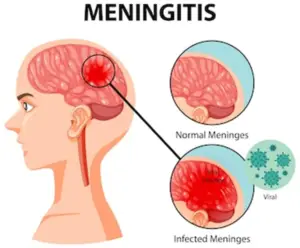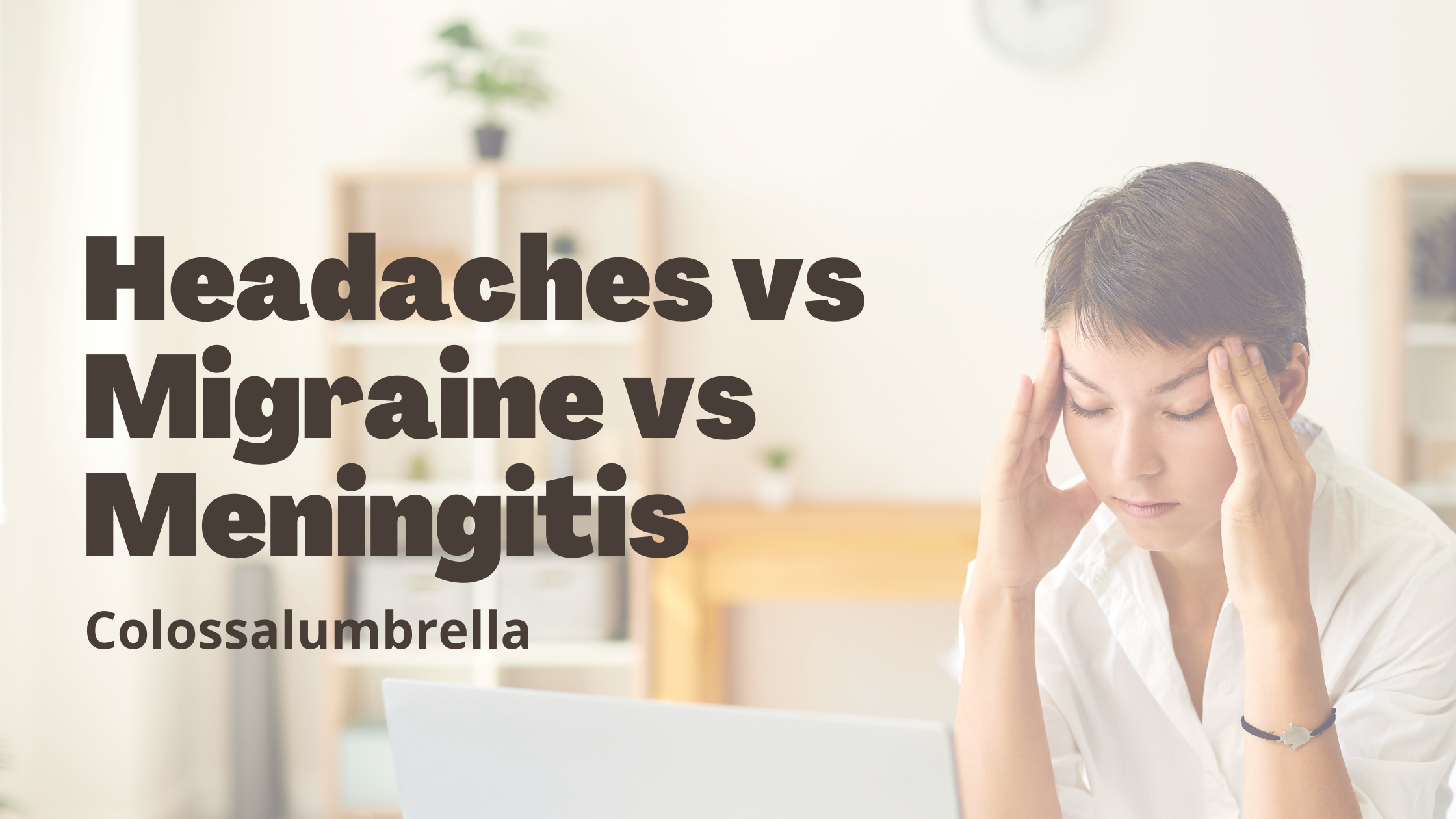It is quite normal to frequent headaches but Migraine headache is quite different than these. This post covers Migraine vs Meningitis, what are the similarities between meningitis and migraine, what is the difference between Meningitis and Migraine, and which is the lesser of two evils. Let us break this down for you so that you know how to treat either one of them. This post is for people who suffer from primary headaches, frequent headaches or tension headache and are unaware of common causes and diseases.
Migraine vs Meningitis
You know that severe headache that just won’t go away? Maybe it’s left you feeling nauseous and sensitive to light or sound. You might have even vomited a few times. But does this mean you have meningitis? Or is it simply another migraine? Both conditions can bring on typical symptoms such as nausea, sensitivity to light and noise, and vomiting. In both cases, you may feel very unwell and experience severe headaches frequently. The main difference between these two conditions lies in their causes, as well as their potential consequences if not treated appropriately.
Headache Statistics
Upon collation of data available, I was surprised to look at number of people who suffer from headaches. The CDC estimates that up to 1 in every 5 people suffers from headaches. The most common types of headaches include migraines, tension-type headaches and cluster headaches. Migraines are the most common type of headache, affecting about 18% of United States population. Tension-type headaches are the next most common, affecting about 11% of Americans.
Cluster headaches are less common, affecting about 1% of Americans. Chronic tension-type headaches may be a sign of an underlying health issue, such as stress or sleep deprivation. Those with chronic migraines should also be evaluated for underlying health issues. Although many cases of migraines can be treated with over-the-counter pain relievers, those with chronic migraines should seek treatment from a medical professional.
According to the American Headache Society, there are more than 70 million people in the US that are suffering from frequent headaches. In fact, headaches are one of the most common reasons why people end up visiting their doctor. In addition to that, around 20 percent of adults (18-64 years of age) experience at least one headache per month. It is also believed that women are more likely to suffer from headaches than men. The reasons for this discrepancy are not entirely clear but it is believed that hormonal changes and fluctuations in blood pressure levels may play a role.
What is Headache?
Headache is a condition that causes pain in the head. It is a very common complaint and can be caused by many different factors, including stress, dehydration, lack of sleep, and hormonal changes. According to the National Headache Foundation, approximately one-third of adults in the US report having regular headaches. While there is no cure for head pain, there are many treatments available that can help to ease the pain, including over-the-counter medications and prescription medications. If you are experiencing frequent headaches, it is important to see your doctor to take medical help to determine the cause and to find the right treatment for head pain.
Types of headaches
There are several different types of headaches that people can experience. The two most common types are tension headaches and migraine headaches. Other types of headaches include cluster headache, headache due to sinus infection, medication overuse headaches. acute headaches, headache disorders,
Additionally, many people report experiencing a dull pain in the neck and shoulders after spending a long time working at a computer or on a mobile device.
Here are 10 Effective Remedies for Headaches and Migraine
Basic knowledge – Migraine vs Meningitis
Meningitis and migraine are both painful medical conditions. Each can cause nausea, sensitivity to light, and other symptoms that make everyday activities difficult. Moreover, both meningitis and migraine can be life-threatening if not treated promptly. Fortunately, there are key differences between the two illnesses that make them easily distinguishable from one another. Understanding how they differ is crucial for getting the right treatment in a timely manner.
Migraine is a type of headache triggered by changes in brain activity. It affects approximately 1 in every 7 people, more commonly women than men, typically beginning between the ages of 10 and 25. The most common type of migraine is known as “migraine with aura,” which accounts for 25% of all cases. People who have migraines with an “aura” experience visual disruptions (often called “headlights” or visual snow) at the onset of their attack.
These visual disruptions may be bright spots or flashing lights, zigzag lines or kaleidoscope images; they almost always begin on one side of the person’s visual field and spread to the other side (not uncommonly covering one entire eye).
Subscribe to Colossalumbrella and grab your free Everyday Planner and printable coloring pages
What are the similarities between meningitis and migraine?
Both conditions can be extremely painful, but also difficult to diagnose. They both usually strike adults in their prime, people of a similar age group, and only rarely affect younger children or older adults.
Migraine is a neurological condition characterized by recurrent headaches with no vascular origin. Symptoms include nausea, photophobia, phonophobia and sometimes visual disturbances such as scotoma.
Meningitis is an inflammation of the meninges caused by bacterial infection, viruses or fungi in the cerebrospinal fluid (CSF). The treatment for each condition is different because they have different etiologies. For more information read on to find out how they differ and what you can do to ease your symptoms if you have either of these conditions.
What is migraine?
Migraines are recurrent headaches that are commonly associated with nausea, vomiting, and sensitivity to light and sound. They may be preceded by visual disturbances, such as flashes of light, flickering lights, or zigzag lines. They are often accompanied by facial pain with or without irritation. They are associated with certain times of day, with certain changes in the weather, and with certain foods (especially chocolate). They can last for 4 to 72 hours and can be debilitating.
Migraine headaches are believed to be caused by changes in the flow of blood in and around the brain. These headaches are not considered to be a result of an infection. However, some research shows that bacteria that are normally found in the body can grow inside blood vessels in the brain during a migraine. The bacteria usually don’t cause any problems when they are on the skin. But inside blood vessels, they can break down the blood-brain barrier and cause a lot of pain.
Fact – Turmeric is a super food. Read more about 9 Surprising Benefits of Turmeric: Why you need to incorporate this super food into your diet?
Meningitis: What is it?
Meningitis is an infection of the protective membranes surrounding the brain and spinal cord. It can be caused by bacterial or viral infection, or even parasites. The infection can occur at any age, but the risk factors is higher in children under the age of 2 years old and in young adults, particularly between the ages of 16 and 25 years old. Common symptoms of Meningitis include a fever, headache, vomiting, and a stiff neck. In some cases pale skin and skin rash.

Source – Freepik
The symptoms may come on quickly, or they may develop over a few days. In bacterial meningitis, the symptoms are more severe than in viral meningitis. Meningitis can be life threatening if left untreated. If diagnosed early, it can be treated with antibiotic therapy. Some people with bacterial meningitis might need to stay in the hospital or may need to be treated in the primary care unit.
Types of Meningitis
Causes of Meningitis is usually by viruses or bacteria. Viral meningitis is the most common type of meningitis, followed by bacterial meningitis. Rare cases of meningitis include chemical and fungal meningitis. Following are types of Meningitis.
- Bacterial Meningitis
- Viral Meningitis
- Fungal Meningitis
- Parasitic Meningitis
- Amebic Meningitis
- Non-Infectious Meningitis
How to tell if you have meningitis or a migraine?
The main difference is that meningitis is a bacterial infection that causes inflammation in the membranes surrounding the brain and spinal cord. It can be life-threatening if left untreated. Migraine is a condition that affects one in seven people. Anyone can have migraine but it usually starts in childhood or adolescence. It is more common in women than in men.
For someone to have meningitis, they must have a bacterial infection. For someone to have a migraine, they do not need to have bacteria. If your head hurts. sensitivity to light and sound, nausea, and vomiting, you are more likely to have a migraine than meningitis.
Migraine vs headache?
If it’s a migraine, headache will be accompanied by nausea, vomiting, sensitivity to light and sound, and increased urination. Meningitis will be accompanied by a stiff neck, a high fever, and a headache (though the headache may not be as bad as the migraine)
Meningitis treatment: Is there a cure?
Migraine vs meningitis: If it’s a migraine, you can take some painkillers and you will be fine. If it’s meningitis, you need to be treated with antibiotic treatment.

Conclusion
Both migraines and meningitis are serious infections that can be life-threatening if left untreated. Both conditions cause similar symptoms, making it difficult to diagnose. Migraine is a common headache disorder that causes recurrent headaches, often with nausea and sensitivity to light and sound. Meningitis is an infection of the meninges, the protective layers around the brain and spinal cord. It can lead to permanent neurological damage or even death if not treated immediately.
Here’s how you can tell these two medical conditions apart, treat them effectively and reduce their frequency. Keep these differences in mind if you ever have a headache and feel sick. The sooner you get treatment, the less likely it is that the infection will spread and the less likely you are to experience long-term serious complications. If in doubt and in severe cases, it is always recommended to see your doctor.
I would personally advice to work towards making significant changes to your lifestyle. Adding simple exercise routine will always lead to a positive impact on your health. I would encourage your to reduce stress and to get more sleep. I have been battling migraine for a few years now. There is no cure but with daily exercise routine and making some dietary changes, I manage to stay away from pain killers. Reducing sugar content and salt from my diet has helped me a lot. I would also suggest increasing your water intake and reduce caffeine.
Disclaimer – This blog provides general information and discussions about health and related subjects. The information and other content provided in this blog, website or in any linked materials are not intended and should not be considered, or used as a substitute for, medical advice, diagnosis or treatment. This blog does not constitute the practice of any medical, nursing or other professional medical care advice, diagnosis or treatment. We cannot diagnose conditions, provide second opinions or make specific treatment recommendations through this blog or website.
